joshoowah
Well-known member
- Joined
- Sep 24, 2011
- Messages
- 646
- Reaction score
- 15
Some of you remember me better than most, as I have been on a hiatus from the forum for some months now. In any case, I used to be an exclusive Caminetto collector, that is, I only bought Caminetto's for a time. I was so for about two years, amassing around 16-17 Caminettos, stretching from the "Business Series" to the "Prestige Series." After finally finding a birth year pipe from the Caminetto line, not an easy task mind you, my love affair with the illusive Caminetto came to an end. The one glee and simplicity that came from such love dissipated and my tastes expanded beyond what Caminetto could provide. My pipe collection dwindled from 50-60 pipes to 8 and counting. The only Caminetto left in my collection is the birth year (1986), but it will always remind me of the fond adventure I had in trying to track down Caminetto's left and right, though now the search is much easier as the popularity of Caminetto is back afresh.
This brings me to the reason of why I am opting to include the history of Caminetto, as well as their shapes (see photo below), their stampings, and dating information. Most of what will be covered can be found with some research, some cannot be found so easily. So, we begin...
History:
Caminetto's history started in 1959 when Guiseppe Ascorti, from Cucciago, and known to his friends as "Peppino", was hired by Carlo Scotti to work at Castello, located in nearby Cantu. Since it's foundation in 1947, Castello had contributed substantially to re-gained glory for Italian pipemaking. Talent and assiduity soon made Ascorti one of Scotti's most notable pipe makers -- a man he counted on for the future. But Ascorti had his own far reaching plan: he wanted to work as a self-employed pipemaker! After his wife Paola had taken over her parent's small greengrocery in the early 60s, this plan became more concrete. The additional income from the shop enabled him to buy tools and machines little by little to furnish his own workshop. By the end of 1968, he was ready and left Castello. Ascorti also persuaded the young and highly talented pipemaker Luigi Radice (born 1939), who was also his next door neighbor in Cucciago, to join him. Carlo Scotti, whom is known as a perfect gentleman, is reported to have spoken unreservedly about this development.
Ascorti & Radice started to manufacture pipes on their own. One of the first who agreed to market their pipes was Gianni Davoli, proprietor of a tobacco shop in Milan. The situation was perfect: two pipemakers in search of a distributor, and a pipe merchant in search of a mainstay brand to market. Davoli - via friends and relations in the States - had made flourishing contacts with US pipe wholesalers and traders. He shipped some pipes across the pond for inspection and received excellent feedback for the very high quality of the pipes. So he shortly after offered to be the sole distributor worldwide and Ascorti & Radice happily accepted.
Then came the legendary evening Ascorti, Radice, and Davoli gathered around the fireplace after a hard day's work enjoying their pipes, a glass of wine, and humorous conversation. Davoli is said to be the one who associated the pipes with the fireplace or chimney, which is "camino" in Italian. Hence "Caminetto", the diminutive (smaller) singular version of camino, was coined as the brand's name. And Ascorti, Radice, and Davoli later became famous as "I tre Camini" - the three chimneys. Maybe, they had more than one glass of wine each, but it's not certain whether the distinctive mustache logo on the stem and the Caminetto slogan "La Pipa del Baffo" - "the pipe with the mustache" - was created the same night. In fact, Ascorti and Radice both wore impressively large mustaches and a pharmacist in the neighborhood had been kidding on them about that. (Davoli, for reasons of corporate identity, later wore a big mustache, too.)
Now Davoli concentrated on marketing the Caminetto brand in the United States. His strategy was as simple as brilliant. There was a remarkable Castello hype at that time. Castello pipes were highly sought after but hard to get due to limited production. Davoli filled the gap, promoting the Caminetto to be absolutely equal to the Castello in terms of quality, but asking only half the price. And best of all: the Caminettos were consignable! The Tinder Box International was put under contract, with successful nationwide distribution. The success was overwhelming - far beyond any expectation, with the rusticated Business line becoming the most popular.
Ironically enough, the increasing demand soon drove Ascorti and Radice to the limits of their production. The brand had been introduced successfully in Germany, and in Italy to some extent. By the end of 1970 more hands were needed. Even Ascorti's elder son, Roberto (born 1958; and the current owner) helped with stamping and shipping the pipes when he was yet a schoolboy. The most important employee is Cesare Vigano, who has worked for Caminetto / Ascorti for more than thirty years. To bring about more stability and higher production, Davoli invested a considerable amount of money in modern pipemaking machinery, and in doing so went from distributor to co-owner of Caminetto. By 1973, he held the vast majority of the company's capital. This would eventually bring about the friction between the "three chimneys."
The boom, especially in the USA, continued strongly. Production increasing steadily as 3,000, 5,000, and then 7,000 pipes per year were made, placing Caminetto at the top of the US sales in their market segment. The 1974 Tinderbox catalog celebrates Gianni Davoli as "master pipe maker and designer" and "the sole creator of the Caminetto" without a single mention of Ascorti or Radice!
In addition to Caminetto, Davoli sold a private label brand by Ascorti / Radice named Gianni for a couple of years in Italy. Caminetto prospered throughout the 70s. Everyone was hard at work, sales continued to increase, but soon there after, disagreements occurred among the three principles, marking the beginning of the end.
First Luigi Radice became increasingly discontent with the factory like production. Pipes were made by standard shape numbers and there was no longer room for his own creative pipemaking and personal development. He was also afraid that the increased production would eventually lead to a reduction in quality. Radice started quarreling with Ascorti about the future course of Caminetto, and they were unable to find a solution. Radice, being an employed pipemaker rather than a partner, could not assert himself. Ascorti shared Radice's concerns about maintaining the quality in the face of the higher production, but Davoli had gained almost total control by this time, insisting on the higher production.
The next controversy was regarding Roberto. The young man had visited a school of arts and also completed his service in the army. Roberto did not want to attend an university and instead started helping in the workshop with pipe repairs, as well as making his first pipes. His father wanted to hire him in as a full-time pipemaker, but Davoli refused, being afraid to lose influence to the potentially strong alliance between father and son.
The situation worsened in 1979. The foreseen quality issues occurred--there were complaints from the US. And there is some indication that Carlo Scotti considered legal actions, asserting that Caminetto had copied some of Castello's successful shapes too exactly. At this point Ascorti wanted to sever ties with Davoli, but Davoli was able to assert himself and maintained control.
I tre Camini disbanded in December of 1979 when Luigi Radice left, without prospects, knowing not where or how he would continue as a pipemaker. A clear indication that he had very strong feelings as to his future with Caminetto.
Ascorti vs. Davoli continued for a few more months. The Ascorti family offered to buy the brand, but they couldn't afford it at the time. So Guiseppe Ascorti hastily equipped a new workshop and then he left the company which was essentially his own, with the complete crew whom he had trained in the old Caminetto workshop following him. And thus they were able to re-start making pipes within a few weeks in 1980. For three months they sold pipes under the name Sergio. Only 800 to 1,000 Sergio pipes were released. Then Giuseppe Ascorti and his son Roberto founded a new company under their own last name -- Ascorti.
Upon leaving Caminetto, Luigi Radice went through huge difficulties, but through the 1980s he also managed to establish himself as independent pipe maker. Gianni Davoli, last chimney standing, stayed behind, now owning a pipe workshop without any pipemakers. Strange enough, the old Caminetto workshop caught fire shortly afterward and burned down to ashes.
It is at this point where details become hazy, as the brand Caminetto seems to have disappeared all but entirely from the market. Some claim Peppino continued to make pipes under the name Caminetto on into the 80s (see smokingpipes.com), but this is fairly unclear and uncertain, particularly because Divoli owned the Caminetto brand and the shop burning down between 1979-1981.
The story picks back up in late 1985 and early 1986, where Roberto Ascorti re-opens the line of Caminetto. Though the "Business" rustication changed somewhat, the original shapes and finishes have largely been left unchanged. From what I can gather, Roberto bought the name Caminetto sometime in 1985. "From who?" is the question, perhaps Divoli himself. Roberto revitalized the once great Caminetto line in memory of his father and the legacy of Caminetto in the Italian pipe industry, as well as to show his capability of producing high quality masterpieces. In saying such, Roberto has been his "flavor" on many of the Caminetto models over the years, stretching and adjusting some shapes to his own liking and style. It seems, by most accounts, he has done well in continuing the Caminetto legacy. One thing that has changed, however, are the prices of the newer lines, which sometimes reach the prices of Castello's themselves.
That is the history of Caminetto as far as I have found in my years of appreciating the brand. It is key to note the particular brands that came out of the fall-out of the original Caminetto that now have a bit of good standing behind them:
1. Luigi Radice -- We all know Radice's work. It is marvelous, fairly unique, and full of passion and heart for the art of pipe making.
2. Roberto Ascorti -- We, too, are familiar with Ascorti, which has produced quality pieces for a number of years, which resemble some of the later years of Caminetto (i.e. 1976-1981).
3. Caminetto -- This, too, is Roberto's work but carries a different flavor to his Ascorti line, resembling some of the work of his father, Peppino, and the original Caminetto, which includes the wax-drip and new dear finish.
4. Enzo Galluzzo -- This is one many may not know about, particularly because the company closed in 1991. In the fallout of Ascorti, Radice, and Divoli, there was another aspiring pipe maker among them who went his own way -- Enzo Galluzzo. Galluzzo invented a new line of pipes in which he branded "Capitello." Capitello took on the character of Caminetto, including some of its shapes and finishes, but Galluzzo produced some real nice pieces for a fraction of the cost of Caminetto, Castello, and even Ascorti. One interesting fact is that Capitello's were the only oil-cured pipes of the 80s, essentially carrying on the tradition of the oil-cured pipe of Caminetto. The company ran from 1982-1991.
Stampings and dating:
First off, dating earlier Caminetto's is nearly impossible. Nevertheless, there were three phases, some in which were much earlier, of development that occurred in the stamping process of Caminetto. Before that though, every pipe had the stamp of Caminetto in one of two ways: Caminetto in script or Caminetto within quotation marks in block letters (I do not know how it was decided which pipe got which stamp, as I have had EARLY Caminetto's with both). The stampings:
1. ASCORTI
RADICE
CUCCIAGO
CANTU-ITALY
2. HAND MADE IN ITALY
CUCCIAGO (Co)
3. MADE IN ITALY
CUCCIAGO (CANTU)
In addition to the above stampings, there was always the trademark mustache on the stem. The earlier models (1968/69-1974/75) had the iconic gold, sometimes white, "bird-in-flight" mustache and the later models (1975-1979/80/81) had a gold, or white, "double comma" mustache. Tinder Box often stamped their shield on the pipes as well.
Now, the question is which stamps are earlier and more likely to have been made by Ascorti and/or Radice. The answer is #1. The differences in #2 and #3 seem to be minute, as Cucciago is simply a suburb of Cantu. Pipes stamped like #1 are the most valuable Caminetto's as they are the earliest production of the brand, as well as what some would claim the most perfect of Ascorti and Radice's work. The last tidbit is, of course, debatable.
There is also another factor in stamping, that is, which series the pipe falls in. The majority of Caminetto's one sees are those of the "Business" series, which are stamped such with their collective shape (see photo of shapes below). Another stamp that sometimes follows the "Business" one is "KS," which from what I know means "King-size" (this could be wrong, as there are pipes stamped with KS1, KS2, and KS3).
The other series is what is known as the "Prestige" series, though I have never seen a Caminetto stamped with "Prestige." It appears that is the name of the collective series of smooth and specialty pipes made by Caminetto and featured in the Tinder Box brochure of old. There are so many different Prestige models, shapes, and finishes , and I have only seen about 5 or 6 of them. The list, per Harvey and other collective resources, is below:
1. Bagdad (Super Briar and Black Briar Moustache--stained black and smooth)
2. Damasco (gold ring affixed to top of bowl; smooth)
3. Double Bowl
4. Excellence, Excellence Extra, and Excellence Flame (natural, light chestnut or walnut; smooth)
5. Green Briar and Green Briar Moustache (stained mahogany or walnut; smooth)
6. Moustache, Moustache KS, KS1, KS2, KS3, and super Moustache (top of the line model; smooth)
7. New Dear, New Dear KS, KS1, and New Dear Moustache (stained light chestnut with or without black smoke ring on rim; roughly carved)
8. Red Briar (stained cherry; smooth)
9. Sable D'Or and Sable D'Or KS, KS1 (black, chestnut, natural, mahogany, red or walnut; sandblast)
10. Tinder Box Golden Anniversary Drainplug (250 made in black or natural sandblast; 51 made in Sable D'Or sandblast or Excellence smooth finishes)
11. Torch (stained mahogany or walnut; smooth)
12. Twin Bowl (only one in existence that I know of, featured in Hacker's book)
To be frank, I have NEVER ever seen personally, in photos, or even for sale a sandblasted prestige pipe. I have owned a Red Briar, a Torch, and an Excellence Flame, all of which were sold for a pretty penny, though I could get more now. I have also have never seen an older New Dear Caminetto that I recall, perhaps I have (who knows). I've seen a Green Briar, which was stunning, and sold for around $500, as well as a smooth Tinder Box limited edition and Bagdad, which was impressive. From what I've seen and experienced, the above is what the pipe will be stamped and not "Prestige." These are the pipes that sell for the most in the Caminetto line from of old and are highly collectible. One other factor that will be different than the Business series is the color of the mustache, which is most often gold in this series (I say most because I've never seen a white mustache on them, which I cannot say that for the Business series).
The newer model Caminetto stampings are quite different and easy to date. Roberto upgraded the stamping technique of Caminetto so that it was possible to figure out when the pipe was made. There are two different types of stamps, one in which is not in use anymore. The first is the traditional "Caminetto" stamp in script, followed by a 4 part grid with numbers. The second is a 3 part stamp (two numbers and one letter, which is most of the time an "L")
The first number in the old stamp of the grid refers to the shape of the pipe. The second number, which is the first in the stamp most are familiar with refers to the grade or of the pipe:
0 standard smooth (red or orange stained)
1 highest grade natural straight-grain smooth (realllllly rare)
2 smooth natural.
6 sandblast
7 New Dear
8 Business finish.
The third number in the old grid stamp is the series.
And the fourth number, which is the third in the newer stampings, refers to the year it was made in. For instance, if one has a 54/6/2/01, they would have a pipe made in the first year of production of the newer Caminetto line (i.e. 1985-86). I include the 85 because some hold that Ascorti was making Caminetto's in 1985, but the majority of who I have talked to and the information I have researched claim official production and retail sale did not begin until 1986.
The second part of the newer stamp is a letter, usually L, which I have no idea what it stands for, but there are others I have seen "B" on. In short, the old stamp has a 2x2 grid specifying the shape, finish, series, and year (in that order), while the newer stamp only shows the finish, the letter 'L', and the year.
For those in need of an example of the 2x2 grid:
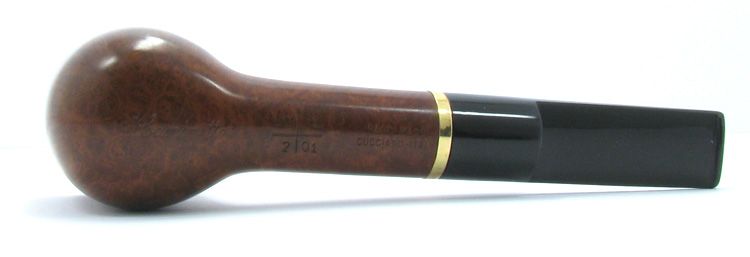 (my birth year Caminetto)
(my birth year Caminetto)
and
 .
.
As said, a lot of this information is available on the web and some of it is not, as I had to call various companies and business reaching for information. In any case, I have collected all of the information in hopes it would be beneficial to another Caminetto lover (Zeno Marx I'm looking at you) and as a way of having all the necessary information in one place. Cheers!
Various shapes of Caminetto, as well as Ascorti:
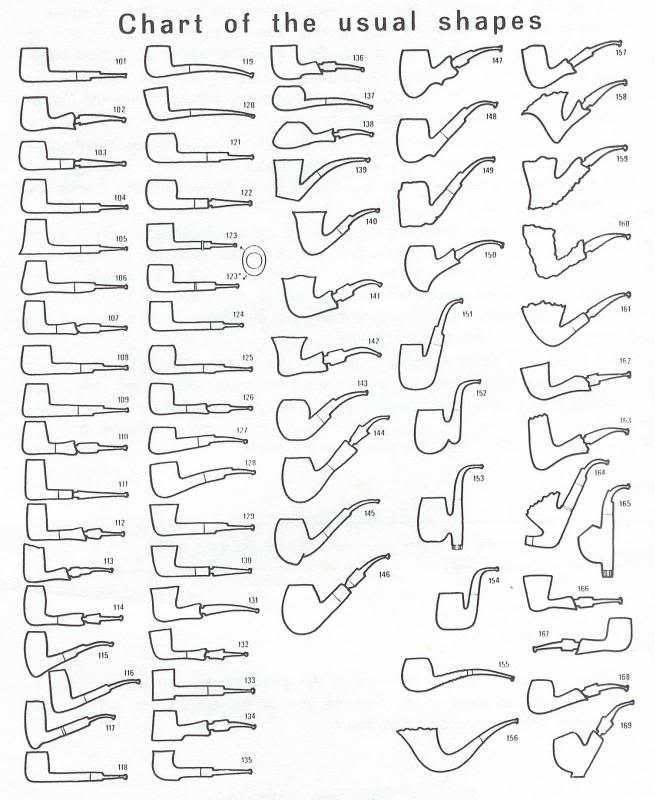
Interview with Harvey Greif:
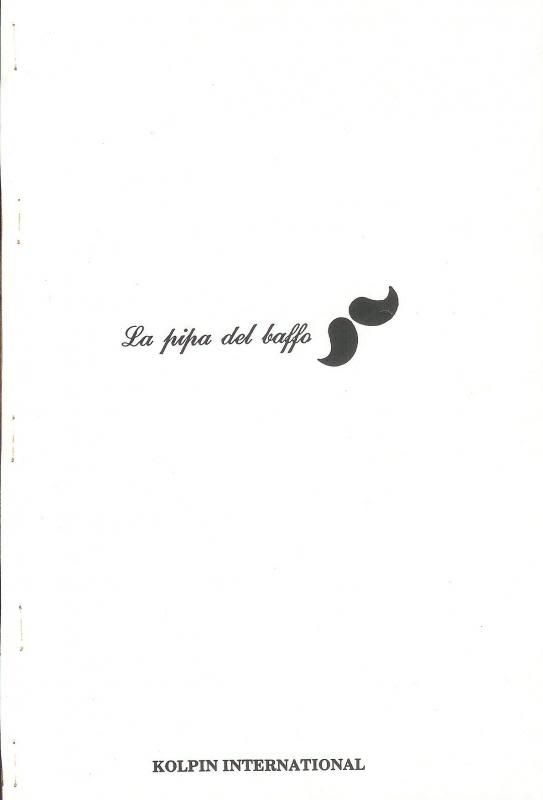
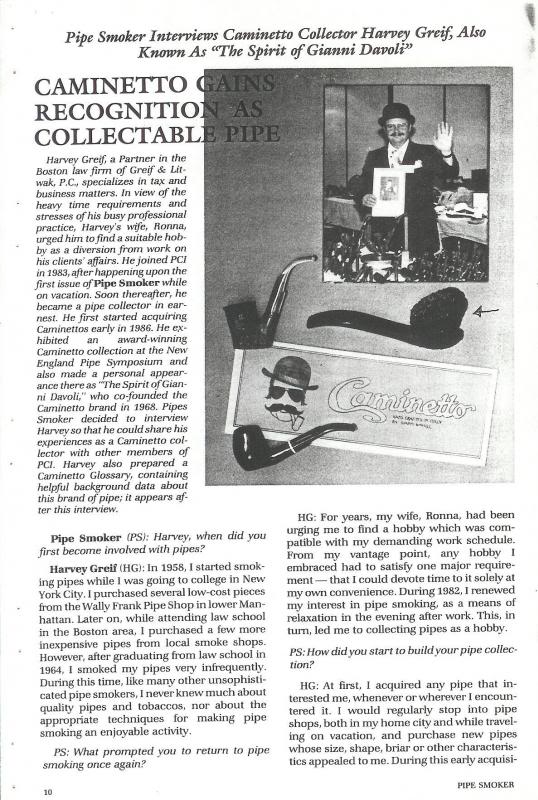

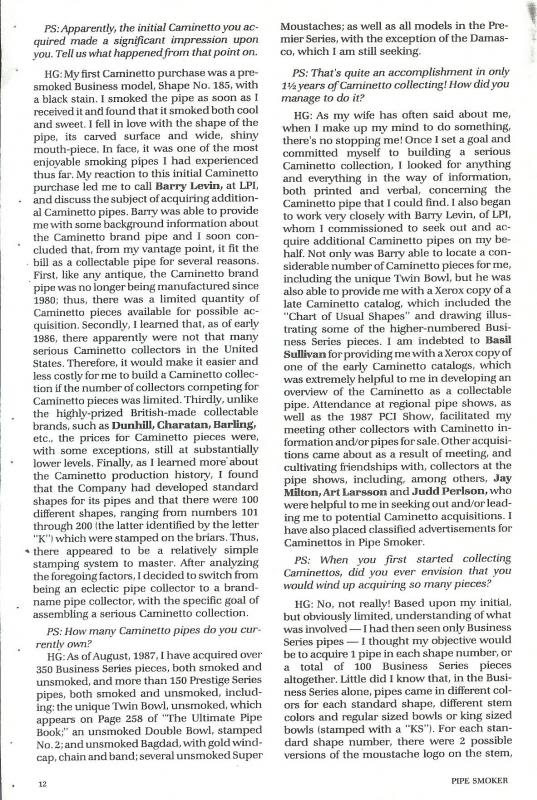
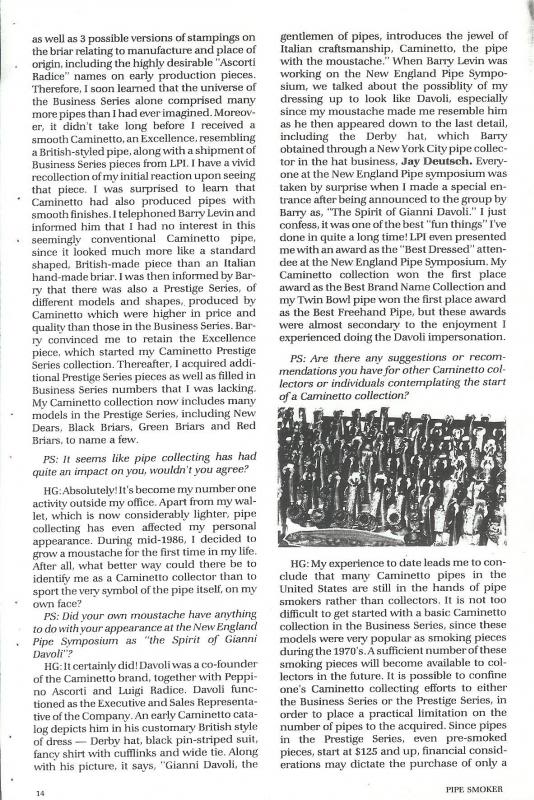

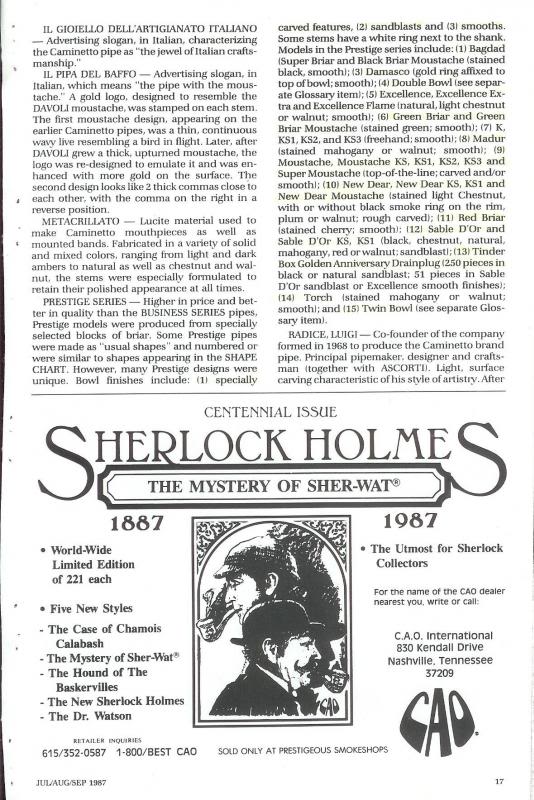
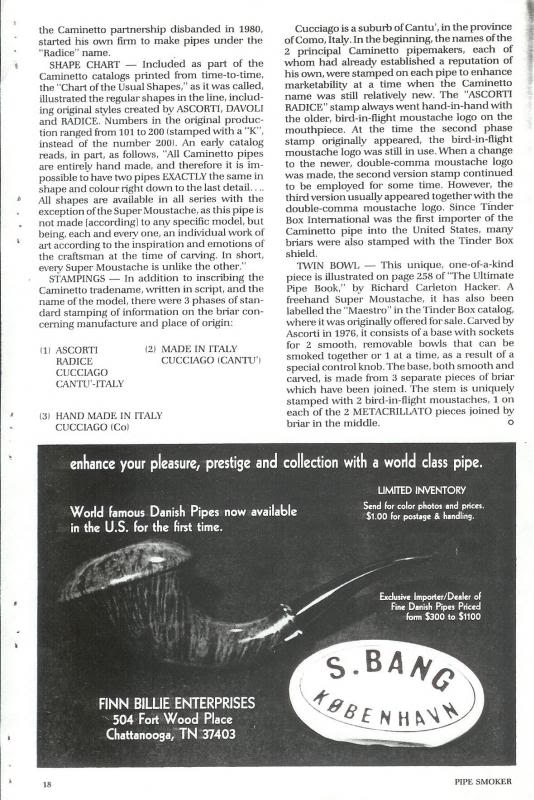
It is also possible that Harvey Greif stamped his own Caminetto's as a property claim:

This brings me to the reason of why I am opting to include the history of Caminetto, as well as their shapes (see photo below), their stampings, and dating information. Most of what will be covered can be found with some research, some cannot be found so easily. So, we begin...
History:
Caminetto's history started in 1959 when Guiseppe Ascorti, from Cucciago, and known to his friends as "Peppino", was hired by Carlo Scotti to work at Castello, located in nearby Cantu. Since it's foundation in 1947, Castello had contributed substantially to re-gained glory for Italian pipemaking. Talent and assiduity soon made Ascorti one of Scotti's most notable pipe makers -- a man he counted on for the future. But Ascorti had his own far reaching plan: he wanted to work as a self-employed pipemaker! After his wife Paola had taken over her parent's small greengrocery in the early 60s, this plan became more concrete. The additional income from the shop enabled him to buy tools and machines little by little to furnish his own workshop. By the end of 1968, he was ready and left Castello. Ascorti also persuaded the young and highly talented pipemaker Luigi Radice (born 1939), who was also his next door neighbor in Cucciago, to join him. Carlo Scotti, whom is known as a perfect gentleman, is reported to have spoken unreservedly about this development.
Ascorti & Radice started to manufacture pipes on their own. One of the first who agreed to market their pipes was Gianni Davoli, proprietor of a tobacco shop in Milan. The situation was perfect: two pipemakers in search of a distributor, and a pipe merchant in search of a mainstay brand to market. Davoli - via friends and relations in the States - had made flourishing contacts with US pipe wholesalers and traders. He shipped some pipes across the pond for inspection and received excellent feedback for the very high quality of the pipes. So he shortly after offered to be the sole distributor worldwide and Ascorti & Radice happily accepted.
Then came the legendary evening Ascorti, Radice, and Davoli gathered around the fireplace after a hard day's work enjoying their pipes, a glass of wine, and humorous conversation. Davoli is said to be the one who associated the pipes with the fireplace or chimney, which is "camino" in Italian. Hence "Caminetto", the diminutive (smaller) singular version of camino, was coined as the brand's name. And Ascorti, Radice, and Davoli later became famous as "I tre Camini" - the three chimneys. Maybe, they had more than one glass of wine each, but it's not certain whether the distinctive mustache logo on the stem and the Caminetto slogan "La Pipa del Baffo" - "the pipe with the mustache" - was created the same night. In fact, Ascorti and Radice both wore impressively large mustaches and a pharmacist in the neighborhood had been kidding on them about that. (Davoli, for reasons of corporate identity, later wore a big mustache, too.)
Now Davoli concentrated on marketing the Caminetto brand in the United States. His strategy was as simple as brilliant. There was a remarkable Castello hype at that time. Castello pipes were highly sought after but hard to get due to limited production. Davoli filled the gap, promoting the Caminetto to be absolutely equal to the Castello in terms of quality, but asking only half the price. And best of all: the Caminettos were consignable! The Tinder Box International was put under contract, with successful nationwide distribution. The success was overwhelming - far beyond any expectation, with the rusticated Business line becoming the most popular.
Ironically enough, the increasing demand soon drove Ascorti and Radice to the limits of their production. The brand had been introduced successfully in Germany, and in Italy to some extent. By the end of 1970 more hands were needed. Even Ascorti's elder son, Roberto (born 1958; and the current owner) helped with stamping and shipping the pipes when he was yet a schoolboy. The most important employee is Cesare Vigano, who has worked for Caminetto / Ascorti for more than thirty years. To bring about more stability and higher production, Davoli invested a considerable amount of money in modern pipemaking machinery, and in doing so went from distributor to co-owner of Caminetto. By 1973, he held the vast majority of the company's capital. This would eventually bring about the friction between the "three chimneys."
The boom, especially in the USA, continued strongly. Production increasing steadily as 3,000, 5,000, and then 7,000 pipes per year were made, placing Caminetto at the top of the US sales in their market segment. The 1974 Tinderbox catalog celebrates Gianni Davoli as "master pipe maker and designer" and "the sole creator of the Caminetto" without a single mention of Ascorti or Radice!
In addition to Caminetto, Davoli sold a private label brand by Ascorti / Radice named Gianni for a couple of years in Italy. Caminetto prospered throughout the 70s. Everyone was hard at work, sales continued to increase, but soon there after, disagreements occurred among the three principles, marking the beginning of the end.
First Luigi Radice became increasingly discontent with the factory like production. Pipes were made by standard shape numbers and there was no longer room for his own creative pipemaking and personal development. He was also afraid that the increased production would eventually lead to a reduction in quality. Radice started quarreling with Ascorti about the future course of Caminetto, and they were unable to find a solution. Radice, being an employed pipemaker rather than a partner, could not assert himself. Ascorti shared Radice's concerns about maintaining the quality in the face of the higher production, but Davoli had gained almost total control by this time, insisting on the higher production.
The next controversy was regarding Roberto. The young man had visited a school of arts and also completed his service in the army. Roberto did not want to attend an university and instead started helping in the workshop with pipe repairs, as well as making his first pipes. His father wanted to hire him in as a full-time pipemaker, but Davoli refused, being afraid to lose influence to the potentially strong alliance between father and son.
The situation worsened in 1979. The foreseen quality issues occurred--there were complaints from the US. And there is some indication that Carlo Scotti considered legal actions, asserting that Caminetto had copied some of Castello's successful shapes too exactly. At this point Ascorti wanted to sever ties with Davoli, but Davoli was able to assert himself and maintained control.
I tre Camini disbanded in December of 1979 when Luigi Radice left, without prospects, knowing not where or how he would continue as a pipemaker. A clear indication that he had very strong feelings as to his future with Caminetto.
Ascorti vs. Davoli continued for a few more months. The Ascorti family offered to buy the brand, but they couldn't afford it at the time. So Guiseppe Ascorti hastily equipped a new workshop and then he left the company which was essentially his own, with the complete crew whom he had trained in the old Caminetto workshop following him. And thus they were able to re-start making pipes within a few weeks in 1980. For three months they sold pipes under the name Sergio. Only 800 to 1,000 Sergio pipes were released. Then Giuseppe Ascorti and his son Roberto founded a new company under their own last name -- Ascorti.
Upon leaving Caminetto, Luigi Radice went through huge difficulties, but through the 1980s he also managed to establish himself as independent pipe maker. Gianni Davoli, last chimney standing, stayed behind, now owning a pipe workshop without any pipemakers. Strange enough, the old Caminetto workshop caught fire shortly afterward and burned down to ashes.
It is at this point where details become hazy, as the brand Caminetto seems to have disappeared all but entirely from the market. Some claim Peppino continued to make pipes under the name Caminetto on into the 80s (see smokingpipes.com), but this is fairly unclear and uncertain, particularly because Divoli owned the Caminetto brand and the shop burning down between 1979-1981.
The story picks back up in late 1985 and early 1986, where Roberto Ascorti re-opens the line of Caminetto. Though the "Business" rustication changed somewhat, the original shapes and finishes have largely been left unchanged. From what I can gather, Roberto bought the name Caminetto sometime in 1985. "From who?" is the question, perhaps Divoli himself. Roberto revitalized the once great Caminetto line in memory of his father and the legacy of Caminetto in the Italian pipe industry, as well as to show his capability of producing high quality masterpieces. In saying such, Roberto has been his "flavor" on many of the Caminetto models over the years, stretching and adjusting some shapes to his own liking and style. It seems, by most accounts, he has done well in continuing the Caminetto legacy. One thing that has changed, however, are the prices of the newer lines, which sometimes reach the prices of Castello's themselves.
That is the history of Caminetto as far as I have found in my years of appreciating the brand. It is key to note the particular brands that came out of the fall-out of the original Caminetto that now have a bit of good standing behind them:
1. Luigi Radice -- We all know Radice's work. It is marvelous, fairly unique, and full of passion and heart for the art of pipe making.
2. Roberto Ascorti -- We, too, are familiar with Ascorti, which has produced quality pieces for a number of years, which resemble some of the later years of Caminetto (i.e. 1976-1981).
3. Caminetto -- This, too, is Roberto's work but carries a different flavor to his Ascorti line, resembling some of the work of his father, Peppino, and the original Caminetto, which includes the wax-drip and new dear finish.
4. Enzo Galluzzo -- This is one many may not know about, particularly because the company closed in 1991. In the fallout of Ascorti, Radice, and Divoli, there was another aspiring pipe maker among them who went his own way -- Enzo Galluzzo. Galluzzo invented a new line of pipes in which he branded "Capitello." Capitello took on the character of Caminetto, including some of its shapes and finishes, but Galluzzo produced some real nice pieces for a fraction of the cost of Caminetto, Castello, and even Ascorti. One interesting fact is that Capitello's were the only oil-cured pipes of the 80s, essentially carrying on the tradition of the oil-cured pipe of Caminetto. The company ran from 1982-1991.
Stampings and dating:
First off, dating earlier Caminetto's is nearly impossible. Nevertheless, there were three phases, some in which were much earlier, of development that occurred in the stamping process of Caminetto. Before that though, every pipe had the stamp of Caminetto in one of two ways: Caminetto in script or Caminetto within quotation marks in block letters (I do not know how it was decided which pipe got which stamp, as I have had EARLY Caminetto's with both). The stampings:
1. ASCORTI
RADICE
CUCCIAGO
CANTU-ITALY
2. HAND MADE IN ITALY
CUCCIAGO (Co)
3. MADE IN ITALY
CUCCIAGO (CANTU)
In addition to the above stampings, there was always the trademark mustache on the stem. The earlier models (1968/69-1974/75) had the iconic gold, sometimes white, "bird-in-flight" mustache and the later models (1975-1979/80/81) had a gold, or white, "double comma" mustache. Tinder Box often stamped their shield on the pipes as well.
Now, the question is which stamps are earlier and more likely to have been made by Ascorti and/or Radice. The answer is #1. The differences in #2 and #3 seem to be minute, as Cucciago is simply a suburb of Cantu. Pipes stamped like #1 are the most valuable Caminetto's as they are the earliest production of the brand, as well as what some would claim the most perfect of Ascorti and Radice's work. The last tidbit is, of course, debatable.
There is also another factor in stamping, that is, which series the pipe falls in. The majority of Caminetto's one sees are those of the "Business" series, which are stamped such with their collective shape (see photo of shapes below). Another stamp that sometimes follows the "Business" one is "KS," which from what I know means "King-size" (this could be wrong, as there are pipes stamped with KS1, KS2, and KS3).
The other series is what is known as the "Prestige" series, though I have never seen a Caminetto stamped with "Prestige." It appears that is the name of the collective series of smooth and specialty pipes made by Caminetto and featured in the Tinder Box brochure of old. There are so many different Prestige models, shapes, and finishes , and I have only seen about 5 or 6 of them. The list, per Harvey and other collective resources, is below:
1. Bagdad (Super Briar and Black Briar Moustache--stained black and smooth)
2. Damasco (gold ring affixed to top of bowl; smooth)
3. Double Bowl
4. Excellence, Excellence Extra, and Excellence Flame (natural, light chestnut or walnut; smooth)
5. Green Briar and Green Briar Moustache (stained mahogany or walnut; smooth)
6. Moustache, Moustache KS, KS1, KS2, KS3, and super Moustache (top of the line model; smooth)
7. New Dear, New Dear KS, KS1, and New Dear Moustache (stained light chestnut with or without black smoke ring on rim; roughly carved)
8. Red Briar (stained cherry; smooth)
9. Sable D'Or and Sable D'Or KS, KS1 (black, chestnut, natural, mahogany, red or walnut; sandblast)
10. Tinder Box Golden Anniversary Drainplug (250 made in black or natural sandblast; 51 made in Sable D'Or sandblast or Excellence smooth finishes)
11. Torch (stained mahogany or walnut; smooth)
12. Twin Bowl (only one in existence that I know of, featured in Hacker's book)
To be frank, I have NEVER ever seen personally, in photos, or even for sale a sandblasted prestige pipe. I have owned a Red Briar, a Torch, and an Excellence Flame, all of which were sold for a pretty penny, though I could get more now. I have also have never seen an older New Dear Caminetto that I recall, perhaps I have (who knows). I've seen a Green Briar, which was stunning, and sold for around $500, as well as a smooth Tinder Box limited edition and Bagdad, which was impressive. From what I've seen and experienced, the above is what the pipe will be stamped and not "Prestige." These are the pipes that sell for the most in the Caminetto line from of old and are highly collectible. One other factor that will be different than the Business series is the color of the mustache, which is most often gold in this series (I say most because I've never seen a white mustache on them, which I cannot say that for the Business series).
The newer model Caminetto stampings are quite different and easy to date. Roberto upgraded the stamping technique of Caminetto so that it was possible to figure out when the pipe was made. There are two different types of stamps, one in which is not in use anymore. The first is the traditional "Caminetto" stamp in script, followed by a 4 part grid with numbers. The second is a 3 part stamp (two numbers and one letter, which is most of the time an "L")
The first number in the old stamp of the grid refers to the shape of the pipe. The second number, which is the first in the stamp most are familiar with refers to the grade or of the pipe:
0 standard smooth (red or orange stained)
1 highest grade natural straight-grain smooth (realllllly rare)
2 smooth natural.
6 sandblast
7 New Dear
8 Business finish.
The third number in the old grid stamp is the series.
And the fourth number, which is the third in the newer stampings, refers to the year it was made in. For instance, if one has a 54/6/2/01, they would have a pipe made in the first year of production of the newer Caminetto line (i.e. 1985-86). I include the 85 because some hold that Ascorti was making Caminetto's in 1985, but the majority of who I have talked to and the information I have researched claim official production and retail sale did not begin until 1986.
The second part of the newer stamp is a letter, usually L, which I have no idea what it stands for, but there are others I have seen "B" on. In short, the old stamp has a 2x2 grid specifying the shape, finish, series, and year (in that order), while the newer stamp only shows the finish, the letter 'L', and the year.
For those in need of an example of the 2x2 grid:

and

As said, a lot of this information is available on the web and some of it is not, as I had to call various companies and business reaching for information. In any case, I have collected all of the information in hopes it would be beneficial to another Caminetto lover (Zeno Marx I'm looking at you) and as a way of having all the necessary information in one place. Cheers!
Various shapes of Caminetto, as well as Ascorti:

Interview with Harvey Greif:








It is also possible that Harvey Greif stamped his own Caminetto's as a property claim:






























![[4PC Bundle] 1/2-Inch Copper Pipe Cleaner Set for Power Drill, 1/2” Tube Cleaning Brush, Cleans Copper Pipes Tubes and Fittings for Soldering, w/ Stainless-Steel Wire Bristles & 1/4” Shank…](https://m.media-amazon.com/images/I/412s2hl0igL._SL500_.jpg)










